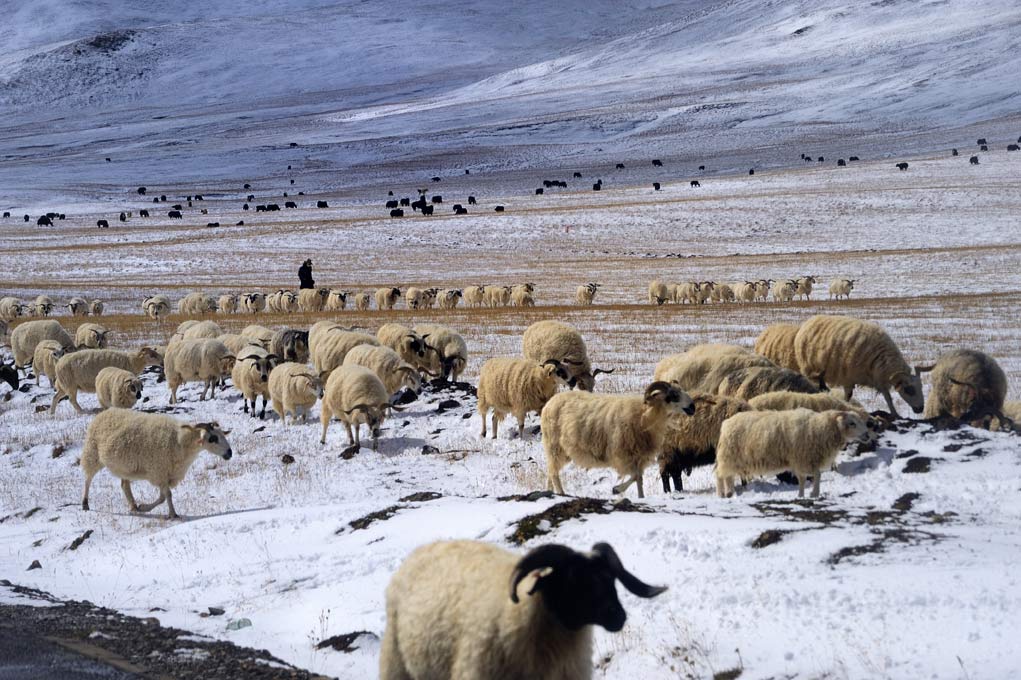Today is the first day of the Tibetan New Year, Losar. This new year, 2142, is the Wood Sheep Year in the Tibetan lunar calendar. The photo below caused me to reflect on sheep and their significance to Tibetan nomadic people. Because Tibetans think of sheep as “the white haired treasure” the year of the Wood Sheep is considered especially auspicious.

Tibetan sheep prefer to live at high altitudes of 3,000 – 5,000 meters (9,800-16,000 feet). The Tibetan word for sheep is luk, however, sheep are often called yangkar, which means “the white haired treasure” because of how valuable they are. Sheep have been raised by Tibetans for thousands of years. For pastoral communities in Tibet, sheep and yak are the main sources of economic activity.
There are various regional and local cultures within Tibetan nomadic communities. Thus, ways of herding, keeping and using domestic animals, including sheep, vary from one community to another. This piece describes some aspects of the practice of the sheep herding culture in the nomadic community of Gedrong Dzatoe in Kham, Tibet.
Gedrong Dzatoe is geographically located at the heart of the Tibetan Plateau, and the Mekong and Yangtze Rivers originate in this region. It has an average altitude height of 4,200 meters (~14,000 feet). Tibetan nomads there have been herding yak, sheep and horses on their vast, highland pastures for generations, 4,000 years or so.
This was one of richest pastoral areas in Tibet in terms of the quantity of livestock. In the good old days, as one of local folk songs from centuries ago says, “There are many happy places in this world. However, the happiest place is my hometown. The painting like scenery that you see is not the haven, but it is my pasture. The flock of thousands of sheep is grazing on the grass hill; the heads of hundreds of yaks are grazing on the vast meadow.”
Wealthy nomadic families used to have 1,000 to 2,000 sheep. The nomads there don’t mark any of their sheep. Marking sheep is a big taboo for Gedrong nomads. Every member or some members in a family recognize all of their sheep. Most of the sheep have names as well. People generally don’t count their sheep, but they know how many sheep they have by a glance at the flock. If any individual sheep is missing, a herdsman can easily find out by looking at the flock for a few seconds.
Lambs are mainly born in late February and March, sometimes, 100 to 200 lambs can be born in a single night. It is a sleepless season for herdsmen of Gedrong Dzatoe. People have to take turns to guard the flock overnight. Many small cozy rooms called tsekhangs are built to place new born lambs. Tsekhang means “play house”. Generally one tsekhang can house 10 to 20 lambs. If a new born lamb is left outside, it can die from the cold weather. As soon as a lamb is born, the shepherd will put some butter in the mouth of the lamb and place it in the tsekhang for the night. The next morning, when the sun rises, lambs are taken out from the tsekhangs and put to their mothers sides one by one. Even though the person saw those lambs only once in the previous dark night at the moment they were born, she or he recognizes which lamb is born to which ewe.
Herdsmen in Gedrong Dzatoe don’t use numbers to count a sheep’s age. There are special terms to count the age of a sheep. A few examples are, lukgu for a newborn lamb, lakga for a one-year-old lamb, tsere for a two-year-old female lamb, thung-nge for two-year-old male lamb, sukpa for three-year-old sheep, and nyipa for four-year-old sheep.
Tibet’s rich nomadic traditions are very important to preserve.
